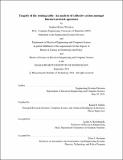Tragedy of the routing table : an analysis of collective action amongst Internet network operators
Author(s)
Woodrow, Stephen Robert
DownloadFull printable version (8.477Mb)
Alternative title
Analysis of collective action amongst Internet network operators
Other Contributors
Massachusetts Institute of Technology. Dept. of Electrical Engineering and Computer Science.
Advisor
Karen R. Sollins.
Terms of use
Metadata
Show full item recordAbstract
This thesis analyzes and discusses the effectiveness of social efforts to achieve collective action amongst Internet network operators in order to manage the growth of the Internet routing table. The size and rate of growth of the Internet routing table is an acknowledged challenge impeding the scalability of our BGP interdomain routing architecture. While most of the work towards a solution to this problem has focused on architectural improvements, an effort launched in the 1990s called the CIDR Report attempts to incentivize route aggregation using social forces and norms in the Internet operator community. This thesis analyzes the behavior of Internet network operators in response to the CIDR Report from 1997 to 2011 to determine whether the Report was effective in achieving this goal. While it is difficult to causally attribute aggregation behavior to appearance on the CIDR report, there is a trend for networks to improve their prefix aggregation following an appearance on the CIDR Report compared to untreated networks. This suggests that the CIDR Report did affect network aggregation behavior, although the routing table continued to grow. This aggregation improvement is most prevalent early in the study period and becomes less apparent as time goes on. Potential causes of the apparent change in efficacy of the Report are discussed and examined using Ostrom's Common Pool Resource framework. The thesis then concludes with a discussion of options for mitigating routing table growth, including the continued use of community forces to better manage the Internet routing table.
Description
Thesis (S.M. in Technology and Policy)--Massachusetts Institute of Technology, Engineering Systems Division, Technology and Policy Program; and, (S.M.)--Massachusetts Institute of Technology, Dept. of Electrical Engineering and Computer Science, 2011. This electronic version was submitted by the student author. The certified thesis is available in the Institute Archives and Special Collections. Cataloged from student submitted PDF version of thesis. Includes bibliographical references (p. 157-163).
Date issued
2011Department
Massachusetts Institute of Technology. Department of Electrical Engineering and Computer Science; Massachusetts Institute of Technology. Engineering Systems Division; Technology and Policy ProgramPublisher
Massachusetts Institute of Technology
Keywords
Engineering Systems Division., Technology and Policy Program., Electrical Engineering and Computer Science.